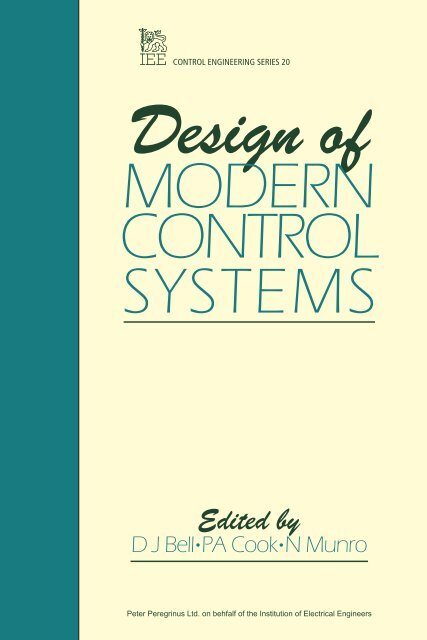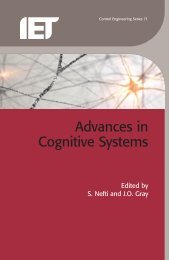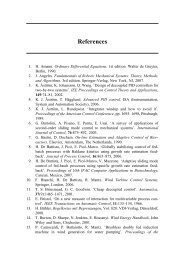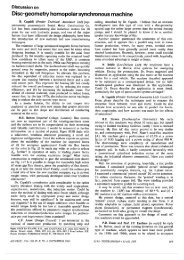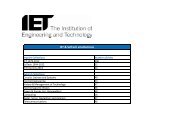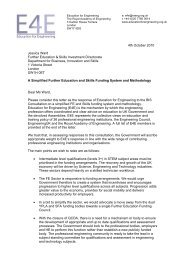Design of Modern Control Systems - IET Digital Library
Design of Modern Control Systems - IET Digital Library
Design of Modern Control Systems - IET Digital Library
You also want an ePaper? Increase the reach of your titles
YUMPU automatically turns print PDFs into web optimized ePapers that Google loves.
<strong>Control</strong> engineering series 20<br />
<strong>Design</strong> <strong>of</strong><br />
MODERN<br />
CONTROL<br />
SYSTEMS<br />
Edited by<br />
D J Bell PA Cook N Munro<br />
• •<br />
Peter Peregrinus Ltd. on behfalf <strong>of</strong> the Institution <strong>of</strong> Electrical Engineers
IEE CONTROL ENGINEERING SERIES 20<br />
Series Editors: Pr<strong>of</strong>. D. P. Atherton<br />
Dr. K. Warwick<br />
CONTROL<br />
SYSTEMS
Other volumes in this series<br />
Volume 1<br />
Volume 2<br />
Multivariable control theory J. M. Layton<br />
Elevator traffic analysis, design and control G. C. Barney and<br />
S. M. Dos Santos<br />
Volume 3 Transducers in digital systems G. A. Woolvet<br />
Volume 4 Supervisory remote control systems R. E. Young<br />
Volume 5 Structure <strong>of</strong> interconnected systems H. Nicholson<br />
Volume 6 Power system control M. J. H. Sterling<br />
Volume 7 Feedback and multivariable systems D. H. Owens<br />
Volume 8 A history <strong>of</strong> control engineering, 1800-1930 S. Bennett<br />
Volume 9 <strong>Modern</strong> approaches to control system design N. Munro (Editor)<br />
Volume 10 <strong>Control</strong> <strong>of</strong> time delay systems J. E. Marshall<br />
Volume 11 Biological systems, modelling and control D. A. Linkens<br />
Volume 12 Modelling <strong>of</strong> dynamical systems—1 H. Nicholson (Editor)<br />
Volume 13 Modelling <strong>of</strong> dynamical systems—2 H. Nicholson (Editor)<br />
Volume 14 Optimal relay and saturating control system synthesis E. P. Ryan<br />
Volume 15 Self-tuning and adaptive control: theory and application C. J. Harris<br />
and S. A. Billings (Editors)<br />
Volume 16 <strong>Systems</strong> modelling and optimisation P. Nash<br />
Volume 17 <strong>Control</strong> in hazardous environments R. E. Young<br />
Volume 18 Applied control theory J. R. Leigh<br />
Volume 19 Stepping motors: a guide to modern theory and practice P. P. Acarnley<br />
Volume 20 <strong>Design</strong> <strong>of</strong> modern control systems D. J. Bell, P. A. Cook<br />
and N. Munro (Editors)<br />
Volume 21 Computer control <strong>of</strong> industrial processes S. Bennett and<br />
D. A. Linkens (Editors)<br />
Volume 22 <strong>Digital</strong> signal processing N. B. Jones (Editor)<br />
Volume 23 Robotic technology A. Pugh (Editor)<br />
Volume 24 Real-time computer control S. Bennett and D. A. Linkens (Editors)<br />
Volume 25 Nonlinear system design S. A. Billings, J. O. Gray and<br />
D. H. Owens (Editors)<br />
Volume 26 Measurement and instrumentation for control M. G. Mylroi and<br />
G. Calvert (Editors)<br />
Volume 27 Process dynamics estimation and control A. Johnson<br />
Volume 28 Robots and automated manufacture J. Billingsley (Editor)<br />
Volume 29 Industrial digital control systems K. Warwick and D. Rees (Editors)<br />
Volume 30 Electromagnetic suspension—dynamics and control P. K. Sinha<br />
Volume 31 Modelling and control <strong>of</strong> fermentation processes J. R. Leigh (Editor)<br />
Volume 32 Multivariable control for industrial applications J. O'Reilly (Editor)<br />
Volume 33 Temperature measurement and control J. R. Leigh<br />
Volume 34 Singular perturbation methodology in control systems D. S. Naidu<br />
Volume 35 Implementation <strong>of</strong> self-tuning controllers K. Warwick (Editor)<br />
Volume 36 Robot control: theory and applications K. Warwick and A. Pugh<br />
(Editors)
CONTROL<br />
SYSTEMS<br />
D J Bell • PA Cook*T\J Munro
Published by: Peter Peregrinus Ltd., London, United Kingdom<br />
© 1982 Peter Peregrinus Ltd.<br />
Reprinted 1988<br />
All rights reserved. No part <strong>of</strong> this publication may be reproduced, stored in<br />
a retrieval system or transmitted in any form or by any means—electronic,<br />
mechanical, photocopying, recording or otherwise—without the prior written<br />
permission <strong>of</strong> the publisher.<br />
While the author and the publishers believe that the information and guidance<br />
given in this work are correct, all parties must rely upon their own skill and judgment<br />
when making use <strong>of</strong> them. Neither the author nor the publishers assume any liability<br />
to anyone for any loss or damage caused by any error or omission in<br />
the work, whether such error or omission is the result <strong>of</strong> negligence or any other<br />
cause. Any and all such liability is disclaimed.<br />
British <strong>Library</strong> Cataloguing in Publication Data.<br />
Bell, D. J.<br />
<strong>Design</strong> <strong>of</strong> modern control systems.<br />
(IEE control engineering series; v. 20)<br />
1. <strong>Control</strong> theory<br />
I. Title II. Cook, P. A. III. Munro, N.<br />
ISBN 0 906048 74 5<br />
Printed in England by Antony Rowe Ltd.
Contents<br />
Preface<br />
1 State-space theory 1<br />
1.1 Introduction 1<br />
1.2 <strong>Control</strong>ability and observability 2<br />
1.3 Standard forms<br />
1.4 Calculation <strong>of</strong> transfer function<br />
matrix 9<br />
1.5 Realizations 11<br />
1.6 Inverse <strong>Systems</strong> 14<br />
References 15<br />
Problems 17<br />
2 Complex variable methods in feedback<br />
<strong>Systems</strong> analysis and design 18<br />
2.1 Introduction 18<br />
2.2 Generalized Nyquist and root-locus<br />
diagrams 19<br />
2.2.1 Characteristic frequencies and<br />
characteristic gains 23<br />
2.2.2 Generalized Nyquist diagrams and<br />
generalized Nyquist stability<br />
criterion 24<br />
2.2.3 Multivariable root loci 25<br />
2.2.4 Conformal nature <strong>of</strong> mapping between<br />
frequency and gain 25<br />
2.3 Zeros 27<br />
2.3.1 Restriction <strong>of</strong> operator in domain<br />
and range 29<br />
2.3.2 Spectral characterisation <strong>of</strong> Zeros 30<br />
2.3.3 Finite zeros when D is non-zero 30<br />
2.4 Bi-linear transformation <strong>of</strong><br />
frequency and gain variables 31<br />
2.5 Geometric theory <strong>of</strong> root locus and<br />
Nyquist diagrams 32<br />
2.6 Angles <strong>of</strong> arrival at zeros and<br />
angles <strong>of</strong> departure from poles 35<br />
2.7 Properties <strong>of</strong> Nyquist and root locus<br />
diagrams for optimal feedback systems 37<br />
2.8 <strong>Design</strong> techniques 38<br />
2.9 Conclusions 40<br />
References 41
Robustness in variable control systems design 46<br />
3.1 Introduction 46<br />
3.2 Sensitivity <strong>of</strong> characteristic gain loci 48<br />
3.2.1 Sensitivity indices 49<br />
3.2.2. Analysis 49<br />
3.3 Uncertainty in a feed back system 51<br />
3.3.1 Normality 53<br />
3.4 Relative stability matrices 53<br />
3.5 Multivariable gain and phase margins 55<br />
3.6 Conclusion 60<br />
References 60<br />
Problems 62<br />
A design study using the characteristic locus<br />
method 64<br />
4.1 Introduction 6 4<br />
4.2 Two-bed reactor model 67<br />
4.3 <strong>Control</strong> system design for Bed II 69<br />
4.4 Compensator design 71<br />
4.5 <strong>Design</strong> <strong>of</strong> the 2-bed system 76<br />
4.6 System performance and properties 77<br />
References 82<br />
The inverse Nyquist array design method 83<br />
5.1 Introduction 83<br />
5.2 The multi variable design problem 84<br />
5.3 Stability 88<br />
5.3.1 Diagonal dominance 91<br />
5.3.2 Further stability theorems 92<br />
5.3.3 Graphical criteria for stability 9 3<br />
5.4 <strong>Design</strong> technique 95<br />
5.5 Conclusions 100<br />
References 101<br />
Appendix 102<br />
Problems 104<br />
Analysis and design <strong>of</strong> a nuclear boiler control<br />
scheme 106<br />
6.1 Introduction<br />
6.2 Drum boiler plant and its control requirements 107<br />
6.3 Multivariable frequency response methods 109<br />
6.4 Analysis and design approach adopted 111<br />
6.4.1 Transfer function model 112<br />
6.4.2 Analysis <strong>of</strong> existing control scheme 113<br />
6.4.3 Alternative control scheme design 116<br />
6.5 Performance assessment <strong>of</strong> improved scheme 120<br />
6.5.1 Three drum version <strong>of</strong> improved scheme 121<br />
6.6 System integrity 122<br />
6.7 Conclusions 124<br />
References 125<br />
Optimal control 126<br />
7.1 The calculus <strong>of</strong> variations: classical theory 12 7<br />
7.2 The optimal control problem 129<br />
7.3 Singular control problems 133<br />
7.3.1 The generalised Legendre-Clebsch<br />
condition: a transformation approach 134
7.3.2 Jacobson's necessary condition 136<br />
7.4 Dynamic programming 137<br />
7.5 The Hamilton-Jacobi approach 140<br />
References 142<br />
Problems 14 3<br />
8 <strong>Control</strong> system design via mathematical programming 14 4<br />
8.1 Introduction 144<br />
8.2 Linear multivariable systems 146<br />
8.3 Non-linear systems<br />
8.4 Semi-infinite programming 152<br />
8.4.1 Feasible-directions algorithms 153<br />
8.4.2 Outer approximations algorithms 155<br />
8.4.3 Non-differentiability 155<br />
8.4.4 Cut-map algorithms 156<br />
8.5 Conclusion 156<br />
References 157<br />
9 Optimisation in multivariable design 159<br />
9.1 Introduction 159<br />
9.1.1 The allocation problem 159<br />
9.1.2 The scaling problem 159<br />
9.1.3 Precompensation design problem 160<br />
9.2 Problem formulation 160<br />
9.2.1 Decomposition 161<br />
9.2.2 Choice <strong>of</strong> dominance measure 161<br />
9.2.3 General problem 162<br />
9.3 Allocation problem 16 3<br />
9.4 Sealing problem 16 5<br />
9.5 Compensation design 16 7<br />
9.6 <strong>Design</strong> example 169<br />
References 17 3<br />
Problems 175<br />
10 Pole assignment 177<br />
10.1 Introduction 177<br />
10.2 State-feedback algorithms 179<br />
10.2.1 Dyadic designs 179<br />
10.2.2 Full-rank designs 183<br />
10.3 Output-feedback algorithms 187<br />
10.3.1 Dyadic designs 189<br />
10.3.2 Full-rank designs 192<br />
10.3.3 Example 194<br />
10.4 Concluding remarks 196<br />
References 19 7<br />
Appendix 198<br />
Problems 200<br />
11 Nonlinear systems 202<br />
11.1 Nonlinear behaviour 202<br />
11.2 Fourier series 203<br />
11.3 The describing function 206<br />
11.4 Prediction <strong>of</strong> limit cycles 210<br />
11.4.1 Frequency response <strong>of</strong> nonlinear<br />
systems 213<br />
11.5 Nonlinear state-space equations 213<br />
11.6 Lyapunov's method 214
11.6.1 Domains <strong>of</strong> attraction 215<br />
11.6.2 Construction <strong>of</strong> Lyapunov's<br />
functions 216<br />
11.7 Absolute stability criteria 218<br />
References 220<br />
Problems 222<br />
12 Some DDC system design procedures<br />
12.1 Introduction 223<br />
12.2 Choice <strong>of</strong> sampling frequency 225<br />
12.3 Frequency domain compensation method 227<br />
12.4 The compensation <strong>of</strong> Class 0<br />
(Regulator) systems 2 30<br />
12.5 Noisy input or output signals 232<br />
12.6 Structural resonances and digital notch<br />
networks 232<br />
12.7 Coefficient quantisation in a discrete<br />
controller 234<br />
12.8 Arithmetic round<strong>of</strong>f-noise in a discrete<br />
controller 237<br />
12.9 Multivate and substrate <strong>Control</strong>lers 2 38<br />
12.10 Comparison <strong>of</strong> time domain synthesis and<br />
frequency domain compensation techniques 240<br />
References 244<br />
13 Robust controller design 246<br />
13.1 Introduction 246<br />
13.2 General problem to be considered 24 7<br />
13.3 The servomechanism problem - structural<br />
results 248<br />
13.3.1 Problem description 248<br />
13.3.2 Existence results 251<br />
13.3.3 Robust servomechanism controller<br />
structure 259<br />
13.3.4 Some properties <strong>of</strong> the robust<br />
controller 261<br />
13.3.5 Various classes <strong>of</strong> stabilizing<br />
compensators 261<br />
13.4 Extensions <strong>of</strong> previous results<br />
13.4.1 <strong>Control</strong> <strong>of</strong> unknown systems<br />
(Multivariable timing regulators) 263<br />
13.4.2 Multivariable error constants 264<br />
13.5 Robust controller design 267<br />
13.5.1 <strong>Design</strong> example 268<br />
13.6 Conclusions 270<br />
References 2 71<br />
14 <strong>Control</strong> <strong>of</strong> distributed parameter systems 274<br />
14.1 Introduction 274<br />
14.2 <strong>Control</strong>lability 278<br />
14.3 Observability 281<br />
14.4 Optimal control 281<br />
14.5 Optimal estimation (Kalman filter) 2 82<br />
References 284<br />
Problems 285<br />
15 Decentralised control 286
15.1 Introduction 2 86<br />
15.2 Non-classical information patterns 286<br />
15.2.1 Partially nested information<br />
structures 2 88<br />
15.3 Decentralised stabilisation and pole<br />
placement 2 89<br />
15.4 <strong>Design</strong> technique <strong>of</strong> decentralised control 294<br />
15.4.1 The algorithm <strong>of</strong> Geromel and<br />
Bernussou 294<br />
15.4.2 The model following method 29 8<br />
15.5 Concluding remarks 301<br />
References 302<br />
Solutions<br />
Chapter 1 304<br />
Chapter 3 306<br />
Chapter 5 309<br />
Chapter 7 313<br />
Chapter 10 316<br />
Chapter 11 324<br />
Chapter 14 32 6<br />
Index 331
Preface<br />
Over the last seven years the Science and Engineering<br />
Research Council (previously the Science Research Council)<br />
have been instrumental in the organization and financing <strong>of</strong><br />
a series <strong>of</strong> vacation schools. These have been aimed primarily<br />
at recipients <strong>of</strong> SFFC postgraduate awards but some<br />
non-SFRC students, together with a few workers from industry<br />
(in the UK and elsewhere) have also taken part. Two <strong>of</strong><br />
these vacation schools have been on the subject <strong>of</strong> analysis<br />
and design <strong>of</strong> control systems and have been held at the<br />
<strong>Control</strong> <strong>Systems</strong> Centre in the University <strong>of</strong> Manchester<br />
Institute <strong>of</strong> Science and Technology (UMIST). The chapters<br />
<strong>of</strong> this present book form the lectures to be given at the<br />
third UMIST vacation school during the week 2 9 March<br />
3 April, 1982. The title <strong>of</strong> the vacation school is the<br />
same as that for this book.<br />
It is inevitable and indeed desirable that a subject such<br />
as engineering design <strong>of</strong> multivariable systems will develop<br />
over a period <strong>of</strong> six years. This becomes apparent if one<br />
compares the contents <strong>of</strong> the 1976 UMIST vacation school as<br />
given in "<strong>Modern</strong> approaches to control system design"<br />
(N. Munro, Fd., IFE <strong>Control</strong> Engineering Series 9, Peter<br />
Peregrinus, 1979) with the contents <strong>of</strong> the volume before you.<br />
Some <strong>of</strong> the 1976 topics no longer appear in this 1982 version,<br />
not because they are now obsolete or research is no<br />
longer taking place in those areas but because we have felt<br />
it right and proper to make way for either new subjects<br />
(such as large scale systems) or interesting new applications<br />
(e.g. the nuclear boiler in Chapter 6). Even in the case
where 1976 topics are retained we have arranged for some<br />
different aspects to be presented in this new publication.<br />
It will be noticed that no fundamental background material<br />
on single-input single-output systems and linear algebra is<br />
presented in the present volume, unlike in the reference<br />
given above. This is because we feel that such material is<br />
readily available from many sources and in particular the<br />
quoted reference may be consulted.<br />
The organization <strong>of</strong> a vacation school and at the same time<br />
the preparation <strong>of</strong> a book to be published before the school<br />
takes place is a daunting task. We certainly would not have<br />
succeeded without the full cooperation <strong>of</strong> all the lecturers<br />
involved in the school, the typist who prepared the cameraready<br />
copy and the staff <strong>of</strong> the publishers. Our grateful<br />
thanks therefore go to all those who honoured deadlines and<br />
delivered the drafts <strong>of</strong> the chapters which follow this preface,<br />
to Vera Butterworth who typed the whole volume under<br />
exceptionally trying circumstances, and to Pauline Maliphant<br />
<strong>of</strong> Peter Peregrinus Ltd. who waited so patiently for the<br />
chapters to arrive at Stevenage from Manchester. This book<br />
would not have appeared but for the support given by the<br />
Science and Engineering Research Council and our sincere<br />
thanks go to staff <strong>of</strong> the SERC and to the other members <strong>of</strong><br />
the planning panel which organized the vacation school.<br />
D.J. Bell<br />
P.A. Cook<br />
N. Munro<br />
Manchester, 1982.


